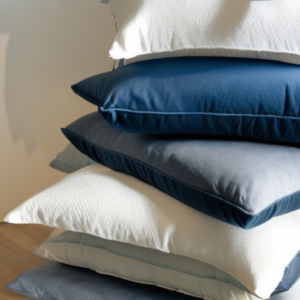Last Updated on February 17, 2023
Are you getting ready to move and feeling a little overwhelmed? Don’t worry, we’ve got your back. We’ll show you how to pack pillows for moving like a pro. Moving can be stressful enough without having the added headache of trying to figure out what is the best way to safely transport those pesky pillows. In this guide, we will cover everything from gathering your supplies all the way through labelling them so that when you get where ever it is that you’re going, there won’t be any surprises waiting for you in terms of your pillow situation. So grab yourself some packing materials, and let’s get started on learning how to pack pillows for moving with ease.
Table of Contents:
Gather Your Supplies
Packing your pillows for a move can be tricky. To make sure they stay safe and secure, you’ll need to gather the right supplies first. Here’s what you’ll need:
1. Boxes – You’ll want sturdy boxes that are large enough to fit your pillows comfortably without crushing them. If possible, use boxes specifically designed for moving fragile items like mattresses and pillows.
2. Bubble wrap or packing paper – This will help protect your pillows from dirt, dust, and other debris during transit. Make sure to get enough bubble wrap or packing paper so each pillow is completely covered with at least two layers of protection on all sides before being placed in the box.
3. Packing tape – Use strong packing tape to seal up the boxes once they’re filled with your pillows and ready for transport. This will ensure that nothing falls out while in transit or storage.
4. Labels – It’s important to label each box containing your pillows clearly so you know which ones go where when it comes time to unpack them later on down the line.
5. Markers – Having markers handy makes labelling easier as well as writing any notes about special instructions such as “Fragile” or “This Side Up” onto the outside of each box if needed.
6. Plastic bags – Using plastic bags helps keep moisture away from delicate items like feather-filled bedding pieces during a move—especially if there is inclement weather involved.
For extra cushioning against bumps along the way, consider using furniture pads around each pillow before placing it into its designated box for added protection against shifting and jostling during transportation.
Once you have all the materials necessary for packing your pillows, it’s time to prepare them for their journey.
Prepare Your Pillows
When it comes to packing pillows, the process can be daunting. But with a few simple steps, you can have your pillows ready for your new home in no time.
Once all of these elements are taken care of, it’s time to get started with wrapping up those precious cushions. Place one pillow into its own bag or case and seal it securely using tape – this will help keep dust and dirt away while in transit/storage too. Make sure that when taping around edges, none of it sticks out so nothing gets caught while being moved around later on down the line, either by yourself or someone else who might be helping with moving house etc. Label each bag/case clearly using a marker so everyone knows which item belongs where once unpacked at its destination point – this way there won’t be any confusion about what goes where afterwards either.

Finally, if you’re feeling extra careful, wrap each individual item inside bubble wrap prior to placing them into their respective bags or cases. This will provide an extra layer of protection against knocks and bumps during transportation, ensuring maximum safety for your beloved bedding pieces throughout their journey until they reach their final destination safely.
By properly preparing your pillows for moving, you can ensure they remain safe and secure during the process. Now that they are ready to go, it’s time to wrap them up so they stay in pristine condition.
Wrap It Up
Wrapping your pillows in protective material is a great way to ensure that they last for years. It’s also an easy and inexpensive way to keep them looking like new. Here are some tips on how to wrap each pillow:
Make sure your pillows are clean before wrapping them up; otherwise, dirt and dust will get trapped inside the protective material when you seal it shut. Vacuum any loose debris from both sides of the pillow before moving on to step three.
Place one piece of packing paper or bubble wrap over the top side of your pillow so that there are at least two inches of extra space around all sides; then tuck in any excess material along the edges until everything looks neat and tidy. Securely tape down all four corners so that nothing moves during transit or storage; if desired, add a label indicating which side should be facing up when unpacking later on down the line. Repeat this process for each additional pillow until finished – voila.
Wrap up your pillows with bubble wrap or blankets to ensure they are well-protected during the move, then pack them into boxes for safe transportation. Now it’s time to “Pack It In” and secure those items for a smooth transition.
Pack It In
Once the pillows have been individually wrapped, it is time to bundle them together into one package for easy transportation and storage. Depending on their size and shape, place two or three pillows side-by-side in a box or bag, then use additional bubble wrap around them until they are firmly secured inside their packaging container. This will help prevent any shifting during transit and reduce the risk of damage due to bumps along the way. Lastly, if desired, add a label so that you can easily identify which items are inside without having to open up every single box/bag when unpacking later on.

Now comes the time for actually putting everything away into its designated spot – whether it be under beds/sofas/chairs etc., in closets/drawers etc., or even just tucked away somewhere out of sight until needed again at some point in future. Start by placing larger packages first, followed by smaller ones; this will help ensure that no space goes unused while also making sure nothing gets lost amongst all those piles of stuff already occupying a said area(s). And don’t forget about labelling once more here, too, if applicable – especially useful when dealing with multiple containers full of goodies…just remember where ya put ’em now.
By packing pillows securely and properly, you can ensure that they arrive safely at your new home. Now let’s take a look at how labelling your boxes will help with the moving process.
Label It
Labelling each box or bag containing pillows is an important step in the packing process. It helps to ensure that all of your items are accounted for and easy to find when you arrive at your destination. There are a few different ways to label each item, depending on what type of material it is made from and how much space you have available.
For fabric bags or boxes, use a permanent marker or fabric pen to write directly onto the material itself. Make sure that whatever writing instrument you choose won’t bleed through the fabric so as not to ruin any other items inside the bag/box. Be sure to include both the contents (i.e., “pillows”) and its intended destination (i.e., “bedroom”). If there isn’t enough room on one side, then flip it over and label both sides with this information.
If using cardboard boxes, use either a permanent marker or labels printed with an adhesive backing that can be stuck onto the outside of each box. Again, make sure to clearly indicate what is inside as well as where it should go once unpacked at its final destination – this will save time during set-up later on.
Plastic containers can also be labelled easily by using waterproof stickers, which come in various sizes and shapes – perfect for labelling plastic bins filled with pillows. These stickers usually come pre-printed, but if needed, they can also be customized with specific words such as “pillow storage” written across them before sticking them onto their respective container(s).
Finally, don’t forget about labelling any extra pillowcases separately as well. This way, everyone knows exactly which pillow belongs in which case; no more guessing games when putting away bedding after long trips away from home.
Conclusion
Moving can be a stressful experience, but it doesn’t have to be. With the right supplies and preparation, you can easily pack pillows for moving with ease. By gathering your supplies, preparing your pillows, wrapping them up securely, packing them in boxes or bags properly and labelling each box clearly – you’ll be ready to move without worrying about damage to your beloved bedding. So don’t let the stress of moving to keep you from getting a good night’s sleep – just remember these tips on how to pack pillows for moving and enjoy the journey.
Paul is the type of person who never met a problem he couldn’t fix. He can always be found tinkering with something in his house, even if it isn’t broken! His tips and tricks are often shared on our site. He’s the one you call when something breaks because he has been known to improvise fixes for everything from leaky faucets to malfunctioning dryers.

